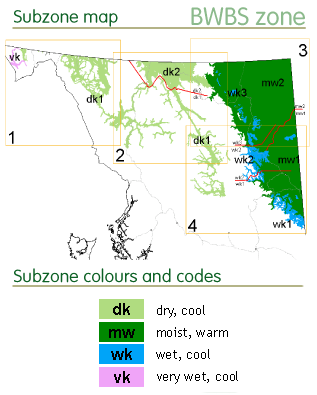Boreal White and Black Spruce Zone
General description
The BWBS zone is the largest forested zone in BC covering 16.3% of the province. It occurs on the Alberta plateau in northeastern BC and in the main valleys west of the Rocky Mountains. At higher elevations the BWBS merges into the subalpine boreal SWB or ESSF zones; at lower elevations it adjoins the warmer sub-boreal SBS or the milder wetter ICH zone.
The boreal climate in this zone is cold continental to hypercontinental. The winters are long and very cold (permafrost is common in some areas) and the summers relatively short (3 month growing season) but warm with frequent high mid-summer temperatures. Precipitation is lower than in most of the adjoining zones. Moisture availability ranges from summer-dry to summer-wet. The centrally located BWBSdk subzone, ranging from 400-1200m in elevation, is the driest and coolest subzone. The small BWBSvk subzone located in the northwest is the warmest and wettest. The two subzones in eastern BC occupy different topographic locations on the landscape. The cooler and wetter BWBSwk subzone occurs at higher elevations (800-1200m) on the mid-lower slopes and foothills of the Rocky Mountains. It is located below the ESSF or SWB zone and above the large, lower lying BWBSmw subzone (300-1000m).
- View detailed subzone maps and climate data for the BWBS zone.
Forest description
 The three main conifers – white spruce, black spruce and lodgepole pine – are found in a variety of different forests types throughout the zone. Mixed stands of white spruce and aspen, or black spruce and lodgepole pine are most common forests in upland areas. Black spruce dominated mossy forests are common on wetter sites and open lodgepole pine – lichen forests on drier sites. White spruce and balsam popular stands are found on richer well-drained sites along rivers. Tamarack is a minor species of importance in most subzones. It forms pure stands on rich fens and swamps, or occurs as a minor component in the stunted black spruce stands which are very common on poorly drained organic soils in lowland areas. Subalpine fir, a common minor species on the zone level, is of greater importance in certain subzones/variants.
The three main conifers – white spruce, black spruce and lodgepole pine – are found in a variety of different forests types throughout the zone. Mixed stands of white spruce and aspen, or black spruce and lodgepole pine are most common forests in upland areas. Black spruce dominated mossy forests are common on wetter sites and open lodgepole pine – lichen forests on drier sites. White spruce and balsam popular stands are found on richer well-drained sites along rivers. Tamarack is a minor species of importance in most subzones. It forms pure stands on rich fens and swamps, or occurs as a minor component in the stunted black spruce stands which are very common on poorly drained organic soils in lowland areas. Subalpine fir, a common minor species on the zone level, is of greater importance in certain subzones/variants.
Grassland and scrub communities occur on steep warm-aspect slopes in the drier portion of the zone. The occurrence of willow, alder, and birch are restricted to specific sites.
- To see how species composition in the BWBS zone varies with climate, view species by subzone pie charts.
Conservation status
Protected areas
There are just over 100 protected areas in the BWBS zone. While many of BC’s largest parks cover parts of the BWBS zone, average coverage is low and unevenly distributed. The large BWBS mw1 and mw2 subzones, located in the Alberta Plateau region, which together cover more than 10% of the province, have less than 3% protected area coverage. Protected area coverage is also notably low in the dk2 subzone on the Liard Plain region. Forests older than 120 years mostly occur on less than 20% of the land area. The units with the highest proportion of older forests are well protected (>25% coverage).
- View protected area distribution on the subzone maps and protected area and land use statistics for the subzone/variants of the BWBS.
Species representation in protected areas
Most of the species in the BWBS zone are well protected. Pin cherry and water birch, which have a small portion of their provincial range in the BWBS, are not expected to occur in any protected areas at threshold values. While they are expected to occur in the protected areas of adjoining zones (the SWB or SBS zone), their populations in the Alberta Plateau region of BC are considered important for genetic conservation. The small, potentially under protected, local populations of jack pine are also considered important for conservation as its presence may decline with climate warming.
- See “BC Tree Species Reports” webpages to view tree species range maps with protected areas, or range maps with conservation statistics by BGC zones.
Conservation priorities
The conservation priorities identified are for the verification of protected area populations of 1) jack pine in the northern BWBSmw2, 2) pin cherry along the Peace River and in the southern BWBSmw1, and 3) water birch in the BWBSmw.
References
The general ecology information presented here has been summarized from the BC MOF brochure on the BWBS zone and the BC MOF publication Meidinger, D. and J. Pojar. 1991. Ecosystems of British Columbia. BC Ministry of Forests, Victoria, BC. 330pp.
The in situ conservation statisitics are from Hamann, A., Smets, P., Aitken, S. N. and Yanchuk, A. D. 2005. An ecogeographic framework for in situ conservation of forest trees in British Columbia. Can. J. For. Res. 35:2553-2561. View online resources.
The in situ conservation status summaries are from C. Chourmouzis, A.D. Yanchuk, A. Hamann, P. Smets, and S.N. Aitken. 2009. Forest Tree Genetic Conservation Status Report 1: In situ conservation status of all indigenous BC species. Centre for Forest Conservation Genetics, Forest Genetics Council of BC, and BC Ministry of Forests and Range, Forest Science Program, Victoria, BC Technical Report 053. www.for.gov.bc.ca/hfd/pubs/Docs/Tr/Tr053.htm. View online resources.
